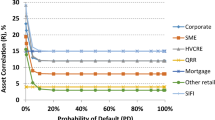Abstract
This paper presents a integrated credit risk modelling approach for private firms which fulfil 2001 Basel Accord requirements in the case of the adoption of the foundation approach. Our model comprises: (a) a bottom-up technique to initially assess the through-the-cycle one-year Probability of Default (PD) and (b) a top-down approach to refine and calibrate this historical PD in a forward-looking credit risk assessment based on next year’s economic outlook. We present findings from applying this model to a large sample of client firms of the Bank of Rome.
Similar content being viewed by others
References
Altman EI (1968) Financial Ratios, Discriminant Analysis and the Prediction of Corporate Bankruptcy. J Finance 23:589–601
Altman E, Saunders A (2001) Credit ratings and the BIS reform agenda. Stern School of Business, New York, March
Altman EI, Bharath S, Saunders A (2002) Credit ratings and the BIS capital adequacy reform agenda. J Bank Finance 26:909–921
Associazione Bancaria Italiana (2000) Methodological Aspects of the Implementation of a System of Internal Rating. Rome, November
Basel Committee on Banking Supervision (2001) The internal rating-based approach. BIS, Consultative document, January
Basel Committee on Banking Supervision (2001) Working Paper on the IRB Treatment of Expected Losses and Future Margin Income, BIS, July
Benink H, Wihlborg C (2002) The New Basel Capital Accord: making it Effective with Stronger Market Discipline. Eur Fin Manag 8:103–115
Birkes D,Yadolah D (1993) Alternative methods of regression. John Wiley & Sons, New York
Bliss R (2002) Comments on “credit ratings and the BIS capital adequacy reform agenda”. J Bank Fin 26:923–928
Burgstahler D, Dichev I (1997) Earning Management to Avoid Earnings Decreases and Losses. J Account Econ 24(1997):99–126
Cantor R (2001) Moody’s Investors Service Response to the Consultative Paper Issued by the Basel Committee on Banking Supervision and its Implications for the Rating Agency Industry. J Bank Fin 25:171–186
Carey M, Hrycay M (2001) Parameterizing Credit Risk Models with Rating Data. J Bank Fin 25:197–270
Carosio G (2001) Proposta di un nuovo accordo sul capitale: Linee generali del secondo documento di consultazionedel gennaio 2001. Bancaria, no.4
Cicardo G (2001) Ambito di applicazione del metodo standardizzato di misurazione del rischio di credito. Bancaria, no.4
Cristiano Zazzara (1999) Il ruolo del capitale nelle banche e la sua regolamentazione: Dall’accordo di Basilea del 1988 ad oggi. Rivista Bancaria Minerva Bancaria, Settembre
Crouhy M, Galai D, Mark R (2000) A Comparative Analysis of the Current Credit Risk Models. J Bank Fin 24:59–117
Duffie D, Lando D (2001) Term Structures of Credit Spreads with Incomplete Accounting Information. Econometrica 69:633–664
Falkenstein E (2001) RiskCalc pivate model: Moody’s default model for private firms: rating methodology. Report, May
Goldman Sachs (2001) Effects of New Basel Accord. European Weekly Analysts no.2001/03, 26th of January
Gordy Michael B (2003) A Risk-Factor Model Foundation for Rating-Based Bank Capital Rules. J Fin Intermed 12:199–232
Griffiths I (1986) Creative Accounting, London, Unwin Paperbacks
Hall SC, Stammerjohan WW (1997) Damage Awards and Earnings Management in the Oil Industry. Account Rev 72:47–65
Hillegeist S, Keating E, Cram D, Lundsted K (2004) Assessing the Probability of Bankruptcy. Rev Account Stud 9:5–34
Morgan JP (1997) Introduction to CreditMetricsTM, Technical Documentation, New York
Jameson M (1988) A practical guide to creative accounting. London, Kogan Page
Jokivuolle E, Peura S (2001) A value-at-risk approach to banks’ capital buffer: an application to the new basel accord. Bank of Finland, Discussion Paper, August
Keasey K, Mc Guinness P (1990) The failure of UK industrial firms for the period 1976–1984. logistic analysis and entropy measures. J Busin Finance Account, 119-135
Krahnen J, Weber M (2001) Generally Accepted Rating Principles: a primer. J Bank Fin 25:3–23
Lando D, Skoderberg T (2002) Analyzing Rating Transitions and Rating Drift with Continuous Observations. J Bank Fin 26:423–444
Laviola S (2001) La riforma dell’Accordo sul Capéitale: il funzionamento del metodo dei ranghi interni. in Bancaria, no.4
Lennox C (1999) Identifying failing companies: a Re-evaluation of the Logit, Probit and DA approaches. J Econ Busin 51:347–364
Löffler G (2004) An Anatomy of RatingThrough the Cycle. J Bank Fin 28:695–720
Mahlmann T (2005) Estimation of Rating Class Transition Probabilities with Incomplete Data. mimeo, University of Koln
Merton R (1977) Theory of Rational Option Pricing. Bell J Econ Manager Sci 4:141–183
Moody’s Investment Service (2000) RiscCalc private model: Moody’s default model for private firms. May
Naser KH (1993) Creative Financial Accounting. Hemel Hempsted, Prentice Hall International
Ohlson J (1980) Financial Ratios and the Probabilistic Prediction of Bankruptcy. J Account Res 19:109–131
Pesaran H, Schuermann T, Treutler B-J, Weiner S (2005), Macroeconomics and credit risk: a global perspective. Journal of Money, Credit and Banking forthcoming, available as Wharton Financial Institutions Center Working Paper #03–13B
Resti A. Omancini (2001) What’s Behind the Credit Rating of European Firms? An Econometric Analysis. Unpublished working paper, University of Bergamo
Sobehart J, Keenan S, Stein R (2000) Benchmarking Quantitative Default Risk Models: a validation methodology, Moody’s Investor Service, Global Credit Research, March
Shumway T (2001) Forecasting Bankruptcy more Accurately: a simple Hazard model. Journal of Business 71:101–124
Wilson Thomas (1997) Portfolio Credit Risk, Risk Magazine October, November
Zazzara C, Sironi A (2001) Il nuovo accordo di Basilea: possibili implicazioni per le Banche Italiane. Bancaria, no.4
Author information
Authors and Affiliations
Corresponding author
Rights and permissions
About this article
Cite this article
Butera, G., Faff, R. An integrated multi-model credit rating system for private firms. Rev Quant Finan Acc 27, 311–340 (2006). https://doi.org/10.1007/s11156-006-9434-7
Issue Date:
DOI: https://doi.org/10.1007/s11156-006-9434-7




